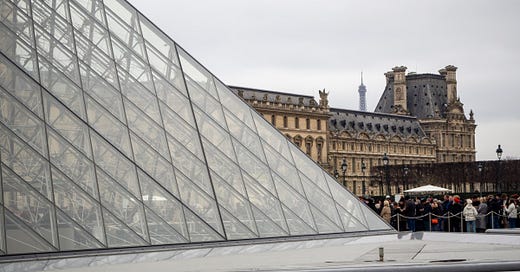We recently returned from a chilly week in Paris (including an unplanned extra night in Lyon on the way home due to missing a train connection). Paris is a huge city, but on a street-level basis, does not feel like a big city, since there are no canyons of skyscrapers like Manhattan, or Tokyo, or other classic “big cities”. There is a strange tiny-town feeling when walking the streets, as the sidewalks are often skinny, and the roads are tangles of angles, lacking ninety degree junctions. There is a similarly strange combination of ornately embellished buildings, fronted by sidewalks paved over in asphalt, like doing away with the Tuileries park and fronting the Louvre with a parking lot instead. Paris could take some notes from the sidewalks of Barcelona, which use patterned tiles, varying by district.
This was my second time in Paris, last time being 1995, and it had been many years since my husband Jim’s last visit. We got swept up in visiting the obiligatories; the Louvre, the Musee d’Orsay, the Orangerie, the Pompidou, among others. Accessing museums like these has transformed in to a rather unpleasant experience in the 21st Century: waits in long lines (even if you bought a timed ticket ahead of time), American airport terminal style security, rude flocks of social media addicts with bad attitudes. This is said to be the slow season so I hate to imagine what these museums are like during the busy season. When we return, which we will as this is a spectacular city, we will heed the advice to visit the smaller, lesser-known museums.
This phenomena of treating museums as sites for “content” creation sadly can not be nipped in the bud as we are way past the “bud” timeframe; at this late stage in the social media takeover of everyday life, some serious pruning must be done. There were the slow-walk-while-looking-vacantly-at-nothing videos being made, and the rushed phone snapshots of a painting, without the phone owner even looking at the painting. These people only ever looked at the art through their phone screen, for a brief couple seconds, before rushing off to snap the next one. And if you have the opportunity to actually get yourself in front of a painting, they will make strange little OOF and SIGHHHH and UG noises, shifting around on their hooves like nervous sheep, until you move on, so they can rush in to take their quick phone snapshot then immediately rush away. Twice I was even shoved out of the way by one of these hideous creatures, so wrapped up in getting the snapshot they did not even notice I was there. But I do not see these museums putting any further controls in place, beyond the usual bans on selfie sticks. The trend of having nude viewing evenings in museums has been picking up lately, and this could actually be a good solution. Fewer people, so you can actually see the art, and no cell phones. Win-win.





Great characterization of the Paris art museum. It's really a shame. And pretty unbelievable that they're doing nothing about it. The solution is simple. Ban images, increase the entrance fee. Maybe take mobile phones away.